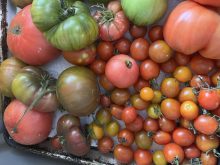My mom tells me my counters are too cluttered. “Why don’t you put some of that stuff away?” she asks me repeatedly. Much of the counter space in my old farmhouse kitchen is occupied by electric tools designed to grind foods or to alter their shape: a food processor, blender and coffee mill stand shoulder to shoulder along one stretch. Crowded cupboards and drawers house an immersion wand and a spice mill.
To my mother’s point: I know if I have to haul a piece of equipment out of a drawer or cupboard, I am not inclined to use it at the drop of a hat, which is sometimes how I cook — so for as long as I have the counter space to house them, I’ll leave those tools out, ready to use. But the point I’m pursuing today is to examine the differing roles of those tools — and to contrast them with a Stone Age, but still viable, alternative: a mortar and pestle, which also sits out on the counter.
I have an assortment of tools because each performs a different task best. My immersion wand, for instance, is spectacularly good at pureeing chunky soups and sauces on the stovetop. It’s also much safer to use than the risky manoeuvre of transporting hot soup to a blender, filling the jar, and having the soup erupt from an unclosed lid and splatter ceiling and self with hot fluids. The blender is, however, pressed into service by Dave when he makes a mango lassi. The coffee mill precisely grinds my beans à la minute for my morning pour-through. My elderly food processor grinds nuts for torte into a fine powder, and makes passable pesto, but only in batches big enough to be pulverized by the blade. It is, however, terrible at pureeing soup or mashing potatoes. Come to think of it, nothing electric is good for mashing potatoes without creating a gluey mess: they require a strong arm and manual masher.
Read Also

Gentle treatments for pain in the neck
Heading toward year-end, people unknowingly tense up against the cold and busyness, causing neck pain that can often be treated with appropriate support and gentle mobility, athletic therapist Kathlyn Hossack says.

That leaves the electric spice mill and my pair of mortars with their pestles. A pestle’s origin is in the Latin, Old French and Middle English words for “pounder” — which is exactly what a ceramic or basalt or marble or wooden pestle does when it meets food contained in the mortar. (Hence the Italian word pesto.) My mortar and pestle make short work of whole spices such as peppercorns, coriander seeds, cumin seeds, allspice and cloves, and makes lush pesto, rendering pinenuts, garlic, basil and olive oil into a velvet blanket for my linguini. I use both electric and manual tools to make massaman curry paste — and star anise is one tough star, so I grind it in the electric spice mill. Then, to clean the electric spice mill so I can grind something less assertive without evidence of curry or star anise, I grind a couple spoons of white sugar.

Using a mortar and pestle encourages a calm, not-to-be-hurried approach to cooking that feels counter-intuitive to busy lives. It’s heavy, so leave it sitting out with your other often-used tools. Pick up the habit of pounding. First we eat, then we discuss which mortar and pestle suits your kitchen.
Roasted smashed fingerling potatoes with Genovese pesto
Spuds in a bar usually take the form of fries or poutine, so this was a wonderful surprise when I encountered it in 3 Hall Public House (formerly the No. 3 fire hall) in Saskatoon.

This volume of classic Genovese pesto is suitable for a food processor. You can vary its taste by changing the nuts and/or herbs: arugula and walnut with artichokes; pumpkin seed and kale; or pistachio, lemon and spearmint (with or without sun-dried tomato slivers or olives, which head more deeply into tapenade territory).
If you spring for a winter-brightener pot of supermarket basil or have an indoor hydroponic plot of plants to pinch back, make a one-quarter-sized batch of pesto in your mortar, adding ingredients one at a time as you pound, starting with garlic, then pine nuts, then basil, salting each addition a little for grit in grinding. Only use freshly grated cheese for the best texture and flavour. Freeze the basil and parsley stalks for stock-making. Freeze extra pesto in small amounts suitable for one or two meals.
Makes about 4 cups of pesto.
Pesto:
- 2 heads garlic, peeled
- 1 c. freshly grated Grana Padano or Reggiano
- ½ c. toasted pine nuts
- 6 c. basil, leaves only
- 1 bunch parsley, leaves only
- ¾ c. fresh lemon juice
- 2 c. extra virgin olive oil
- Salt and pepper to taste

Potatoes:
- 1 lb. fingerling potatoes
- Extra virgin olive oil for drizzling
- Salt and pepper to taste
- ½ c. pesto
- ½ c. Grana Padano or Reggiano plus extra for garnish
- 4 minced green onions
To make pesto, put garlic, cheese and pine nuts in food processor and grind to a fine paste. Heap herbs on top, close lid, and start motor running while adding lemon juice and oil. Stop and scrape down the sides several times, and season to taste.
Preheat oven to 400 F. Leave potatoes whole and cook in salted water until tender. Drain. Flatten each one with the back of a metal egg lifter and transfer to make a single layer on a parchment-lined baking sheet. Drizzle with oil and sprinkle with salt and pepper. Roast until crisp, about 20-30 minutes. Toss with pesto, then garnish with cheese and green onions. Serve hot.















